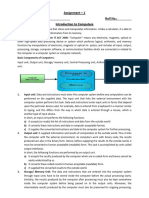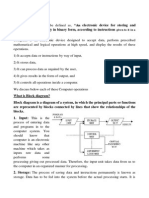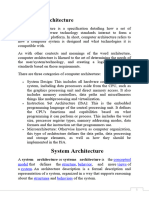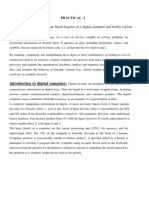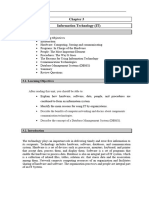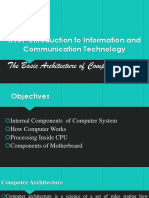What Is Computer Architecture
Uploaded by
Videos BankWhat Is Computer Architecture
Uploaded by
Videos BankWhat is Computer Architecture?
Computer architecture is a specification describing how hardware and software technologies interact to
create a computer platform or system. When we think of the word architecture, we think of building a
house or a building. Keeping that same principle in mind, computer architecture involves building a
computer and all that goes into a computer system. Computer architecture consists of three main
categories.
System design – This includes all the hardware parts, such as CPU, data processors, multiprocessors, memory
controllers and direct memory access. This part is the actual computer system.
Instruction set architecture – This includes the CPU’s functions and capabilities, the CPU’s programming
language, data formats, processor register types and instructions used by computer programmers. This part is
the software that makes it run, such as Windows or Photoshop or similar programs.
Microarchitecture – This defines the data processing and storage element or data paths and how they should be
implemented into the instruction set architecture. These might include DVD storage devices or similar devices.
All these parts go together in a certain order and must be developed in a pattern so they will function
correctly.
https://www.computersciencedegreehub.com/faq/what-is-computer-architecture/
Basic System Architecture
The processor alone is incapable of successfully performing any
tasks. It requires memory (for program and data storage), support
logic, and at least one I/O device (“input/output device”) used to
transfer data between the computer and the outside world. The basic
computer system is shown in Figure 1-2.
Figure 1-2. Basic computer system
Designing Embedded Hardware, 2nd Edition
by John Catsoulis
Released May 2005
1. The processor is the workhorse of the system; it is the component that executes
a program by performing arithmetic and logical operations on data. It is the
only component that creates new information by combining or modifying
current information.
In a typical system there will be only one processor, known at the central
processing unit, or CPU. Modern high performance systems, for example
vector processors and parallel processors, often have more than one processor.
Systems with only one processor are serial processors, or, especially among
computational scientists, scalar processors.
2. Memory is a passive component that simply stores information until it is
requested by another part of the system. During normal operations it feeds
instructions and data to the processor, and at other times it is the source or
destination of data transferred by I/O devices. Information in a memory is
accessed by its address.
3. Input/output (I/O) devices transfer information without altering it between the
external world and one or more internal components. I/O devices can be
secondary memories, for example disks and tapes, or devices used to
communicate directly with users, such as video displays, keyboards, and
mouses.
4. The communication channels that tie the system together can either be simple
links that connect two devices or more complex switches that interconnect
several components and allow any two of them to communicate at a given point
in time. When a switch is configured to allow two devices to exchange
information, all other devices that rely on the switch are blocked, i.e. they must
wait until the switch can be reconfigured.
https://www.phy.ornl.gov/csep/ca/node2.html
You might also like
- The Orthodox Youth Divine Liturgy Handbook100% (1)The Orthodox Youth Divine Liturgy Handbook22 pages
- Note On System Performance Evaluation CSC 508No ratings yetNote On System Performance Evaluation CSC 50864 pages
- Computer Organization and Architecture NotesNo ratings yetComputer Organization and Architecture Notes15 pages
- Kalinga University Department of Computer ScienceNo ratings yetKalinga University Department of Computer Science29 pages
- ICT Resources & Technology Enabled learningNo ratings yetICT Resources & Technology Enabled learning199 pages
- 5EC3-01: Computer Architecture: Unit-I What Are Digital Computers?No ratings yet5EC3-01: Computer Architecture: Unit-I What Are Digital Computers?19 pages
- Computer System: Prepared By: Suresh KhatiwadaNo ratings yetComputer System: Prepared By: Suresh Khatiwada18 pages
- 2nd Quarter - Review - INSTALLING AND CONFIGURING COMPUTER SYSTEMSNo ratings yet2nd Quarter - Review - INSTALLING AND CONFIGURING COMPUTER SYSTEMS21 pages
- University of Dar Es Salaam: College of Information and Technology (Coict) Course Code: Is 158No ratings yetUniversity of Dar Es Salaam: College of Information and Technology (Coict) Course Code: Is 15818 pages
- The Basic Architecture of Computer SystemNo ratings yetThe Basic Architecture of Computer System30 pages
- Top Level View of Computer Function and Interconnection (1)No ratings yetTop Level View of Computer Function and Interconnection (1)2 pages
- Explain Block Diagram of Computer and Its ComponentsNo ratings yetExplain Block Diagram of Computer and Its Components7 pages
- Computer Science - CE - 2013 - Section ANo ratings yetComputer Science - CE - 2013 - Section A48 pages
- Iprocurement Creating Blanket RequisitionNo ratings yetIprocurement Creating Blanket Requisition3 pages
- Solutions of Equations in One Variable The Bisection MethodNo ratings yetSolutions of Equations in One Variable The Bisection Method28 pages
- Student Attendance Management System With Fingerprint SoftwareNo ratings yetStudent Attendance Management System With Fingerprint Software5 pages
- Muhammads Message in Mecca Warnings Signs and MiraclesNo ratings yetMuhammads Message in Mecca Warnings Signs and Miracles22 pages
- Varga Timea A HEALING CHILD GOD IN ROMAN DACIA THE CULT OF TELESPHORUS, THE CONVALESCENCE GODNo ratings yetVarga Timea A HEALING CHILD GOD IN ROMAN DACIA THE CULT OF TELESPHORUS, THE CONVALESCENCE GOD24 pages
- Art of Communication A Nurses Guide To Implementing Best Practice in CommunicationNo ratings yetArt of Communication A Nurses Guide To Implementing Best Practice in Communication50 pages
- Padre Faura Witnesses The Execution of Rizal: 21 Century Literature From The Philippines and The WorldNo ratings yetPadre Faura Witnesses The Execution of Rizal: 21 Century Literature From The Philippines and The World12 pages
- Reducing Absenteeism and Empowering Student-Peer Relationship Through Cooperative LearningNo ratings yetReducing Absenteeism and Empowering Student-Peer Relationship Through Cooperative Learning4 pages
- Paper-Iii English: Signature and Name of InvigilatorNo ratings yetPaper-Iii English: Signature and Name of Invigilator32 pages











